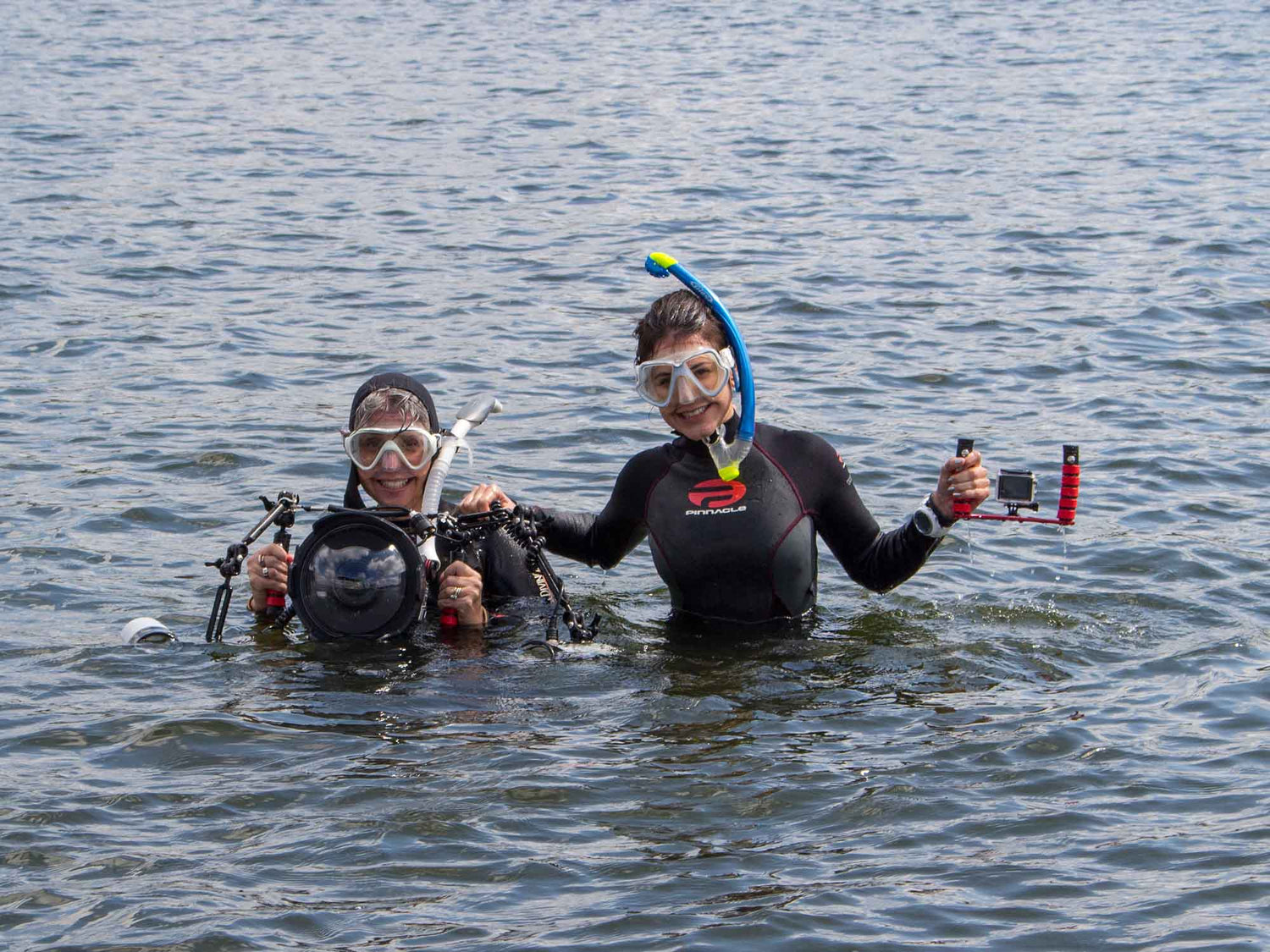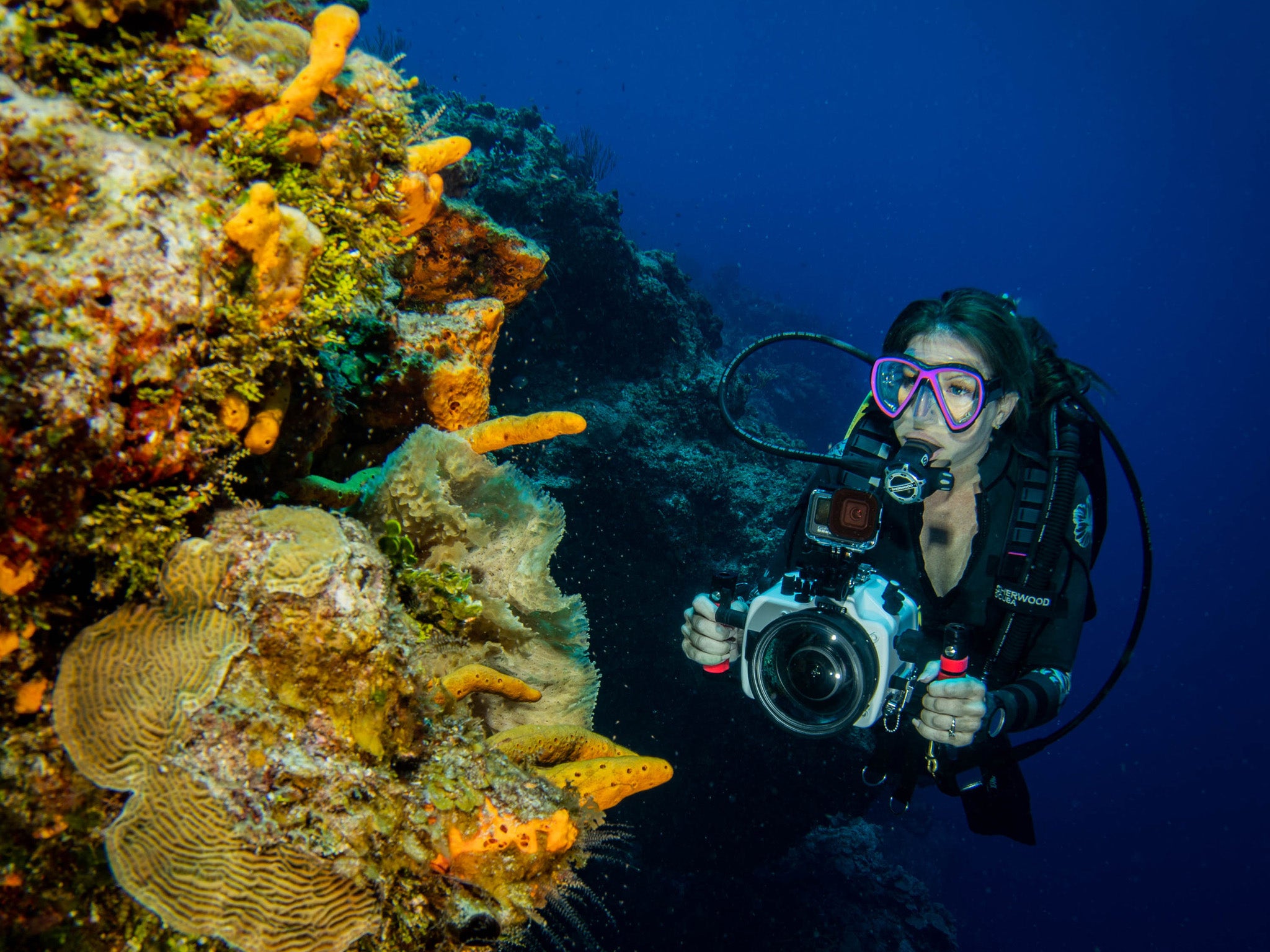By Jean Rydberg
There can be a lot of excitement underwater, from using new camera gear to all of the wonderful things we’re dropping down to see (hopefully). It can be easy to lose sight of the basics that will bring us back to the surface in good health with our life and limbs in tact. Here are my recommendations for staying safe - and looking like you know what you’re doing - when you go underwater with your camera system.
Depth
The average marine animal can handle depth changes way better than humans can. One minute a sea turtle is cruising over the reef, and the next moment it’s going straight to the surface for a breath of air. Fight the urge to follow and try shooting some silhouette shots instead. Ascending too quickly will increase your risk of decompression illness (DCI) and other pressure related injuries.
It can go the other way too. I’ve found myself casually following a stingray, shark, pufferfish - you name it - to depths that are way beyond my dive profile. This can quickly cut your morning dive time to under 30 minutes.

This turtle may look innocent but he's about to shoot to the surface much more quickly than you can do safely. Chasing the wildlife is never a good idea, and it can be particularly dangerous when there are big changes in depth involved. Photo © 2022 Steve Miller
No-Deco Time
This brings me to watching your dive computer in general. You don’t have to be deep to blow your profile. I have found my computer switched over to decompression diving mode on a shallow second dive - maybe more than once - while distracted by schools of fish and dancing light rays at 25-35 feet (7-10 meters). And depending on your circumstances, your computer may add more than a minute or two to your normal safety stop.
There are two things that will definitely aggravate a boat diving operator: staying down for 1:15 on an hour long dive or coming up with your computer blaring decompression limit alarms. I recommend doing the responsible thing for your health - and the respectful thing for your operator - and stay within your computer limits.
Pro Tip: I like to have a wrist computer - sometimes even mounted to the top of my housing - so that I can frequently check my stats while I’m shooting. Often I also have a computer attached to my first stage as well. Note that if have two computers with one dangling below you on a hose, then it may end with different limits from the one on your wrist.

Did you just drop an extra 20 feet (7 meters) to get that perfect close focus wide angle (CFWA) shot of your buddy and a huge piece of soft coral? Depending on the starting depth, this can substantially impact your dive profile and corresponding no decompression times. Photo © 2022 Steve Miller
Your Surroundings
Some of my dive buddies in the past seem to have the impression that I’m not very - shall we say - present. That is, I may have exhibited a tendency to separate from them, ignore their needs, and occasionally even completely lose track of my position in relation to our desired ascent location.
The potential safety issues here may be obvious but let me spell them out for you. For one, if you or your buddy gets into a low air or decompression limit situation you will not be in a position to respond appropriately. Running out of air underwater is no joke and leaving yourself or your buddy with only the option of shooting to the surface for the next breath is crazy dangerous for reasons we discussed earlier. We are not turtles.
Think you’re good on air consumption? Think again when you have an extra 15-minute kick back to the boat. Add one or two (controlled) ascents to the surface to see where the boat is, and even the most zen diver among us will be getting close to the end of their tank.
This is all complicated if you happen to be diving in a current - or even worse, unexpectedly run into one. A strong can current can quickly move you several hundred meters away from your exit point and/or completely exhaust you on your swim back.

Have you seen your buddy lately? Getting distracted while shooting photos is a great way to lose your partner underwater. If you're not paying attention you're probably not close enough to address any equipment failures, out of air emergencies, or even worse situations. Photo © 2022 John Brigham
Buoyancy and Trim
You know what makes that swim even harder? A few extra pounds of camera gear and a big dome port. Plan for the size, shape, and weight of your underwater rig to affect your personal buoyancy and exertion. I’ve been in situations where I drop down to 80 feet (25 meters) and feel like I can’t put air back into my BCD fast enough. This can leave me in an annoying circumstance of constantly inflating and deflating my jacket with every change of depth along my dive. In tropical conditions I generally don’t dive with much weight to begin with and often drop 1-2 pounds if I’m diving with a heavy lens and strobes. You can also use buoyancy devices on your camera system. Just be aware it may take more than you expect to make your system neutral. Aluminum buoyancy arms need to be fairly large to even offset their own negative buoyancy.

This looks like the perfect place for me to lay on the sand at maximum depth at the end of my second "shallow dive" and blow right past my no-deco time. It's easy to get lost in yourself when you're shooting a cooperative subject. Make sure your computer is front and center so that you can also keep an eye on your vital stats. Photo © 2022 Steve Miller
Clips and Lanyards
We deal with a lot of gear to get underwater and take photos, and it’s important to streamline that equipment as much as possible. Dangling hoses and cords can damage the reef and put you in danger if they get caught on the edges of a wreck or some hard corals.
I find it’s critical for my comfort and safety to have simple clips on my BCD for my pressure gauge and spare regulator. If you’re renting gear at the dive site, often they won’t have these simple devices installed so I recommend traveling with them even if you leave your BCD at home.
Many people like a lanyard or clip on their rig but I generally avoid attaching the camera system to my body. It makes it harder for me to be conscious of what my system may be running into and I find few situations where I want my system dangling from a string underwater. Most systems are balanced enough that you can release hold of them for a second underwater if necessary without losing it. I also have been known assume a “seated position” underwater and balance my rig on my thighs if I need to do something with both hands. If you choose to attach your gear choose the right lanyard. There’s a large variety out there with options of clips, buckles, retractable lines, or coiled cords, etc. Do not use a lanyard to carry your system on the surface- most aren’t designed for this purpose. Our classic breakaway lanyard is designed specifically to give way in case your housing or flashlight gets caught on something.

Jumping from subject to subject underwater can quickly leave you pretty far from your desired exit point. You don't want to find yourself on an extra 20-minute kick back to the boat. Photo © 2022 Steve Miller
Know yourself
We call diving a sport but it is not a competition. As with any adventurous activity you’ll be wanting to push your boundaries occasionally. Just be mindful that things can go wrong underwater and no shot is worth serious injury or death. You’re also responsible to your dive buddy and the operation that’s taking you out, so please also avoid putting others in a dangerous or uncomfortable position on your behalf!
 Jean Rydberg, daughter of Ike Brigham, became President & CEO of Ikelite in 2006. Prior to that, she wisely pursued a degree in Astronomy & Astrophysics to prepare herself for the challenges of running a technology-driven manufacturing business with global distribution. Jean fully embraces the need to travel outside of her hometown of Indianapolis to experience good diving. She believes that any camera is capable of amazing results in the right hands, and anyone can become a great photographer given the right advice. When she's not working she's spending time with her husband, cats, and two daughters (though not necessarily in that order).
Jean Rydberg, daughter of Ike Brigham, became President & CEO of Ikelite in 2006. Prior to that, she wisely pursued a degree in Astronomy & Astrophysics to prepare herself for the challenges of running a technology-driven manufacturing business with global distribution. Jean fully embraces the need to travel outside of her hometown of Indianapolis to experience good diving. She believes that any camera is capable of amazing results in the right hands, and anyone can become a great photographer given the right advice. When she's not working she's spending time with her husband, cats, and two daughters (though not necessarily in that order).
Additional Reading
What I Wish I Knew When I Started in Underwater Photography [VIDEO]
How Underwater Maternity is Different From Topside
The Importance of Hitting the Water with a Shot in Mind [VIDEO]
Featured Photographer: Bryant Turffs on Looking Deeper













